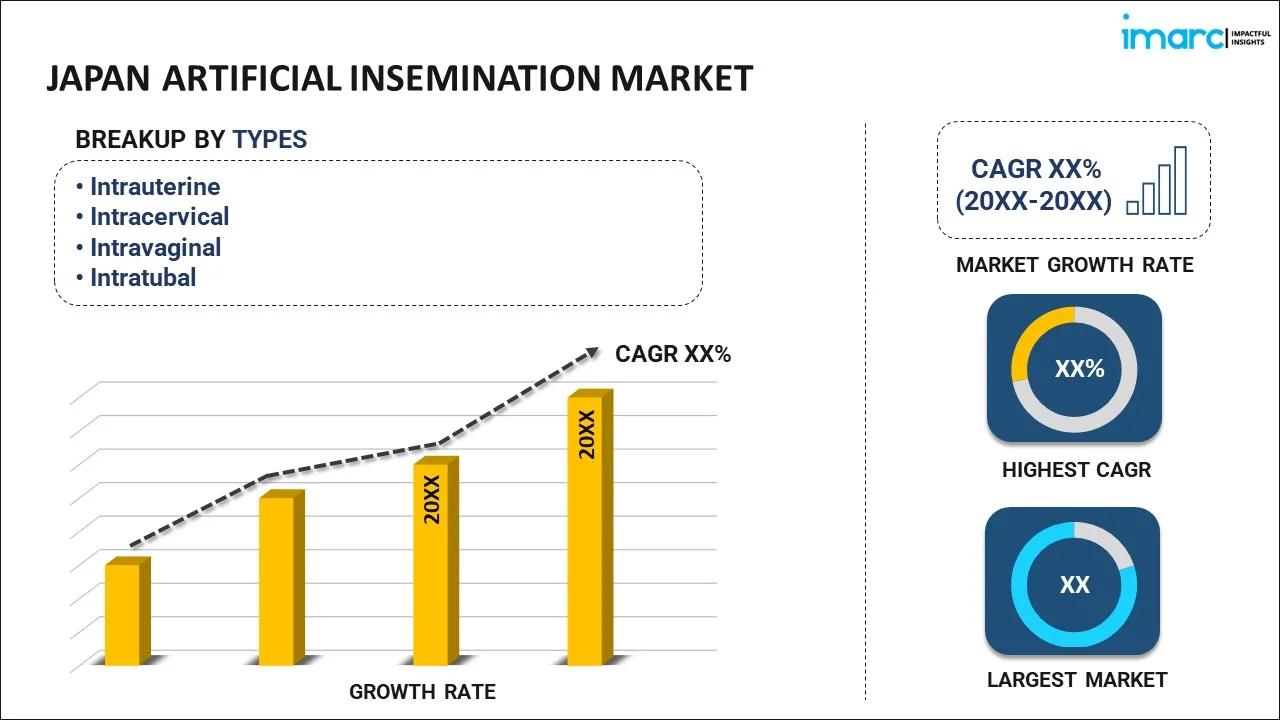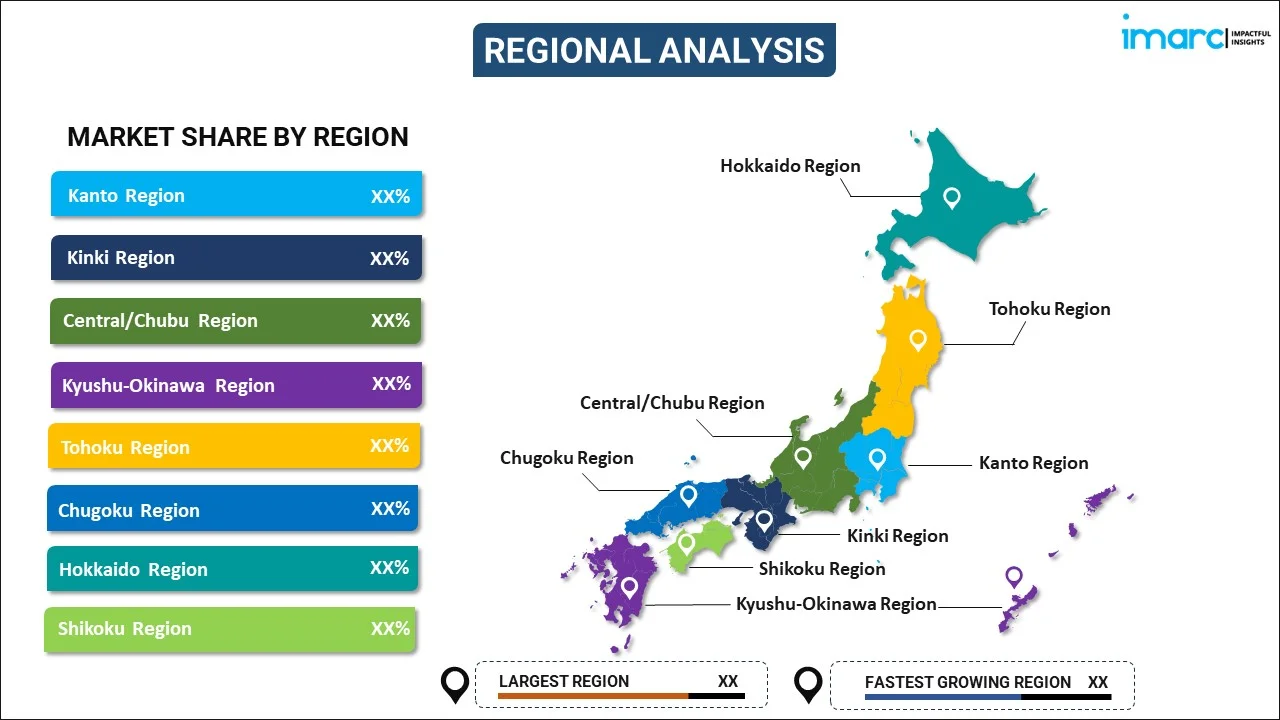
Japan Artificial Insemination Market Report by Type (Intrauterine, Intracervical, Intravaginal, Intratubal), Source Type (AIH-Husband, AID-Donor), End Use (Hospitals and Clinics, Fertility Centers, and Others), and Region 2025-2033
Market Overview:
The Japan artificial insemination market size is projected to exhibit a growth rate (CAGR) of 5.6% during 2025-2033. The increasing awareness about reproductive health, the rising demand for artificial insemination as a viable option for couples experiencing fertility issues and shifts in demographic trends represents some of the key factors driving the growth of the market.
|
Report Attribute
|
Key Statistics
|
|---|---|
|
Base Year
|
2024
|
|
Forecast Years
|
2025-2033
|
|
Historical Years
|
2019-2024
|
| Market Growth Rate 2025-2033 | 5.6% |
Artificial insemination (AI) is a biomedical method of achieving pregnancy by placing sperm directly into a woman's uterus, cervix, or fallopian tubes. Developed as a solution for couples experiencing infertility issues, it has become a common practice in human fertility treatments as well as in animal breeding. One of the defining characteristics of AI is that it bypasses certain biological barriers to natural fertilization, such as physical obstructions or low sperm count. In humans, the sperm used can either be from a known or anonymous donor, or the woman's partner. The most common type of AI is intrauterine insemination (IUI), where sperm is placed in the uterus, thereby increasing the chances of successful fertilization. AI also provides important features for animal husbandry. It allows for the selection of high-quality genetic traits, helps control diseases, and improves the efficiency of breeding programs. This has made AI a significant tool in livestock industries worldwide. While artificial insemination can significantly increase the likelihood of pregnancy, the procedure doesn't guarantee success. Factors such as age, general health, and fertility issues can affect the outcome. Nonetheless, it continues to be a beacon of hope for countless couples and a key tool in animal breeding.
Japan Artificial Insemination Market Trends:
The rapid urbanization and shifts in demographic trends in Japan are stimulating the demand for advanced reproductive technologies, such as artificial insemination. This serves as a pivotal driver for the market growth of artificial insemination services. The increasing awareness about reproductive health and rising demand for artificial insemination as a viable option for couples experiencing fertility issues are contributing to the market growth. Similarly, the advancement in reproductive technologies, offering safer and more effective procedures, is meeting the demand for family planning solutions, thereby driving market growth. The swift socio-economic development in Japan, combined with a society more open to modern reproductive methods, is enhancing the market growth. Along with this, the expansion of online health platforms offering extensive information and consultation for artificial insemination is boosting the market. The rising focus on reproductive health and wellness trends are leading to an increased demand for specialized and advanced services, facilitating the market growth. Furthermore, ethical considerations in healthcare are urging providers to optimize their services and increase patient-friendly, empathetic offerings. Government initiatives promoting birth rates and family planning are also contributing significantly. Moreover, the improved awareness about fertility treatments and the preference for private and confidential healthcare services are accelerating the market growth. Decentralization in healthcare services is fostering local clinics, which is further driving market growth. Other factors, such as regulatory policies supporting reproductive health, the aging population, and significant technological advancements in artificial insemination, are further driving the artificial insemination market growth across Japan.
Japan Artificial Insemination Market Segmentation
IMARC Group provides an analysis of the key trends in each segment of the Japan artificial insemination market report, along with forecasts at the country level for 2025-2033. Our report has categorized the market based on type, source type, and end user.
Type Insights:

- Intrauterine
- Intracervical
- Intravaginal
- Intratubal
The report has provided a detailed breakup and analysis of the market based on the type. This includes intrauterine, intracervical, intravaginal, and intratubal.
Source Type Insights:
- AIH-Husband
- AID-Donor
A detailed breakup and analysis of the market based on the source type has also been provided in the report. This includes AIH-husband and AID-donor.
End Use Insights:
- Hospitals and Clinics
- Fertility Centers
- Others
A detailed breakup and analysis of the market based on the end use has also been provided in the report. This includes hospitals and clinics, fertility centers and others.
Regional Insights:

- Kanto Region
- Kinki Region
- Central/ Chubu Region
- Kyushu-Okinawa Region
- Tohoku Region
- Chugoku Region
- Hokkaido Region
- Shikoku Region
The report has also provided a comprehensive analysis of all the major regional markets, which include Kanto region, Kinki region, Central/ Chubu region, Kyushu-Okinawa region, Tohoku region, Chugoku region, Hokkaido region, and Shikoku region.
Competitive Landscape:
The report has also provided a comprehensive analysis of the competitive landscape in the market. Competitive analysis such as market structure, key player positioning, top winning strategies, competitive dashboard, and company evaluation quadrant has been covered in the report. Also, detailed profiles of all major companies have been provided.
Japan Artificial Insemination Market Report Coverage:
| Report Features | Details |
|---|---|
| Base Year of the Analysis | 2024 |
| Historical Period | 2019-2024 |
| Forecast Period | 2025-2033 |
| Units | Million USD |
| Scope of the Report | Exploration of Historical and Forecast Trends, Industry Catalysts and Challenges, Segment-Wise Historical and Predictive Market Assessment:
|
| Types Covered | Intrauterine, Intracervical, Intravaginal, Intratubal |
| Source Types Covered | AIH-Husband, AID-Donor |
| End Uses Covered | Hospitals and Clinics, Fertility Centers, Others |
| Regions Covered | Kanto Region, Kinki Region, Central/Chubu Region, Kyushu-Okinawa Region, Tohoku Region, Chugoku Region, Hokkaido Region, Shikoku Region |
| Customization Scope | 10% Free Customization |
| Post-Sale Analyst Support | 10-12 Weeks |
| Delivery Format | PDF and Excel through Email (We can also provide the editable version of the report in PPT/Word format on special request) |
Key Questions Answered in This Report:
- How has the Japan artificial insemination market performed so far and how will it perform in the coming years?
- What has been the impact of COVID-19 on the Japan artificial insemination market?
- What is the breakup of the Japan artificial insemination market on the basis of type?
- What is the breakup of the Japan artificial insemination market on the basis of source type?
- What is the breakup of the Japan artificial insemination market on the basis of end use?
- What are the various stages in the value chain of the Japan artificial insemination market?
- What are the key driving factors and challenges in the Japan artificial insemination market?
- What is the structure of the Japan artificial insemination market and who are the key players?
- What is the degree of competition in the Japan artificial insemination market?
Key Benefits for Stakeholders:
- IMARC’s report offers a comprehensive quantitative analysis of various market segments, historical and current market trends, market forecasts, and dynamics of the Japan artificial insemination market from 2019-2033.
- The research study provides the latest information on the market drivers, challenges, and opportunities in the Japan artificial insemination market.
- Porter's five forces analysis assist stakeholders in assessing the impact of new entrants, competitive rivalry, supplier power, buyer power, and the threat of substitution. It helps stakeholders to analyse the level of competition within the Japan artificial insemination industry and its attractiveness.
- Competitive landscape allows stakeholders to understand their competitive environment and provides an insight into the current positions of key players in the market.
Need more help?
- Speak to our experienced analysts for insights on the current market scenarios.
- Include additional segments and countries to customize the report as per your requirement.
- Gain an unparalleled competitive advantage in your domain by understanding how to utilize the report and positively impacting your operations and revenue.
- For further assistance, please connect with our analysts.
 Inquire Before Buying
Inquire Before Buying
 Speak to an Analyst
Speak to an Analyst
 Request Brochure
Request Brochure
 Request Customization
Request Customization




.webp)




.webp)












